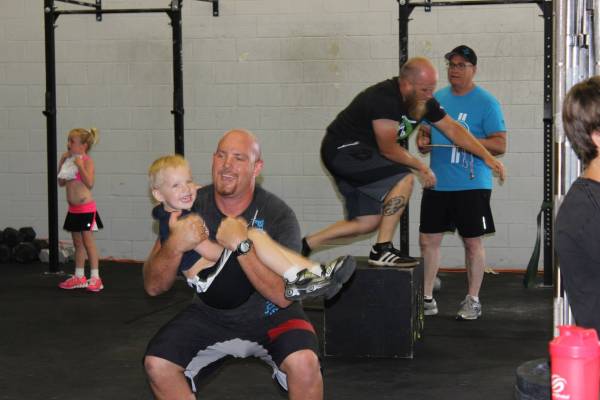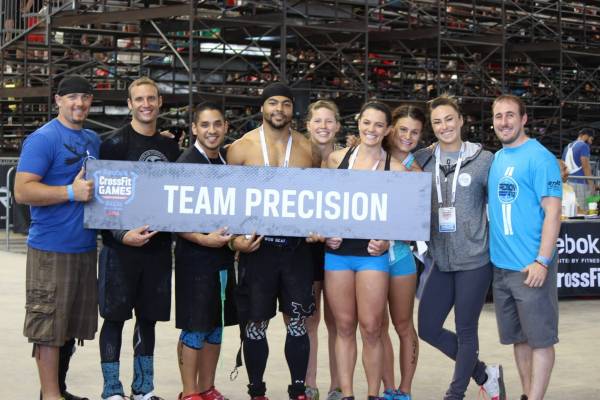At seven and a half months post-op, I competed in the sport of CrossFit again – after fully rupturing my left Achilles tendon. I have tried not to make a big deal of it.
Post-op after fully rupturing my Achilles tendon.
I have not posted much on what I have been doing in order to get to this point. I’ve not previously shared what I’ve done to recover from what many call a “devastating injury.” But I am going to do so now because there are so many misconceptions as to what you can and can’t do after an Achilles rupture.
Initial Treatment
When I first injured myself, I immediately took measures to prepare for surgery. I changed my diet to only eating things that would reduce inflammation. I saw my physical therapist, Dan Wick of Custom Physical Therapy, to get treatment to reduce swelling and improve healing.
Many do not understand the importance of getting treatment before having a major surgery. By allowing the body to begin the healing process, you’re preparing yourself to handle the trauma of surgery. The reduction of inflammation also speeds up your post-op recovery.
After a week of being diligent, my body was primed for operation. My injury site had virtually no swelling or bruising. Some people have to wait several weeks to reach this state where they are considered by the doctors to be ready for such a big reconstruction.
“[T]here are so many misconceptions as to what you can and can’t do after an Achilles rupture.”
Recovery Methods
As soon as my surgery was done, I began my recovery. I continued to eat inflammation-reducing foods and took supplements that my mother, Bonni Tromello who is a functional medicine provider prescribed for me.
To relieve inflammation:
- Whole30 Diet Plan: grass-fed meat, wild caught fish, and pastured eggs as much as possible.
- InflammaCore or UltraInflamX: two scoops, one to two times daily
- Traumeric: two capsules daily
- Orthomega 820 Fish Oil: two capsules daily
To clean up cellular debris:
To promote healing:
- Protein: 1.5 grams per kg of body weight
- Great Lakes Collagen Hydrolysate: four tablespoons daily, mixed with fluid
- Buffered vitamin C: 2,000mg twice a day, as tolerated
- Mom’s chicken soup or other source of bone broth
I followed this routine religiously and found it to be a powerful part of my recovery process.

Midway through my recovery in a walking boot, excited to get back to coaching.
The Power of Positivity
What I feel was most influential in my recovery is that I remained positive. I saw my situation as a blessing rather than a curse. A means to slow me down and enjoy what life had to offer besides training.
Sitting in that surgical cast, I only wanted three things:
- To be able to walk in some way, shape, or form to help my wife take care of our children. I felt so hopeless. If anything were to happen to them, what could I do to help? This was a horrible feeling.
- To be able to run so I could play with my kids again. I wanted this more than anything
- To coach. I wanted to become better at my craft. This realization was a long time coming and this injury put me in the right mindset to take on this task. It also was one of the only things I knew I could still do well.
Baby Steps of Progress
I started rehab as soon I could muster enough strength. First, I wiggled my toes a lot. Funny, I know. I then began to hop around. Believe it or not, this was taxing. I did static lifts from a seated position, worked my abdominals, and rowed single-legged on an ergometer.
The weeks blended together as I went from cast to cast, and then at seven weeks post-op, I finally got a boot. This meant I could start working with my physical therapist to take my recovery up another level.
“Although with a limp, I walked. But that day when I chased after my kids again? Wow.”
For one month, I literally jumped head first into a pool three times a week. I followed a routine that included calf raises, leg abduction and adduction, squats, jumps, lunges, hops, raises, lifts, and water treading of different sorts. I took lessons to learn how to swim properly to add another avenue of fitness into my routine.
Everything my physical therapist told me to do, I did like my life depended on it. I worked my ass off using the same work ethic I had always been known for, but this time it was for my survival, and even the survival of my children.
At every appointment, my physical therapist would do something called remodeling. He would work my Achilles repair adhesions with various tools to reduce the scar tissue so it would heal correctly. These were some of the most painful experiences, but I did not care because I knew it was making me better.

The happiest moment of my recovery – playing with my kids again.
The best day ever was when I got to wear tennis shoes again on both feet. This came at fourteen weeks after surgery. It was so nice just to walk. Although with a limp, I walked. But that day when I chased after my kids again? Wow. I don’t recall the exact day because I just did it. I remember crying out of happiness at regaining the ability to move with my children again.
I began plyometric and hamstring strengthening drills at the fifteen-week mark. This included single-leg hops, trampoline hopping, various agility drills, and yes – single-leg rebound box jumps. Although I worried, I trusted my therapist’s expertise.
The Complete Outline of My Rehab Procedure
- Post injury assessment and care: Ice, interferential and high volt galvanic stimulation for swelling reduction.
- Week Seven: Pool therapy.
- Week Ten: Ultrasound, myofascial release, functional mobilization to ankle, subtalar joints, mid-foot mobility for re-supination, neuromuscular reeducation of foot mechanics, stability, lower extremity tracking. All through this process focused on remodeling repair adhesions, managing fascial mobility, muscle length.
- Early exercise program: Foot intrinsic and ankle strength, stretching (contract/relax and long duration slant board), balance board activities.
- Week Twelve: Squatting, calf raises, weight-bearing ankle exercises, single-leg balance activities.
- Week Thirteen: BOSU balance activities (toss/catch, rotations) with perturbations. Resisted gait training, lunges, static toe-off holds (lower extremity extension/hip drive).
- Week Fourteen: Shuttle press calf work, minimum weight-bearing hops.
- Week Fifteen: Triple extension weight lifts, 45-pound maximum.
- Week Sixteen: Trampoline hopping, focus on eccentric landing control. Skipping activities, increased shuttle hop height, resistance.
- Week Seventeen: Progressive toe walking, continued work on eccentric control, still couldn’t land hop with deceleration. Critical mobilizations at this time became ankle dorsiflexion mobility and subtalar glides/gapping/shear.
- Week Nineteen: Hopping squares at twelve inches, multi-directional jumps. Increased single-leg squat depth. Also started single-legged hopping onto five-inch step/box.
- Week Twenty: Increase hopping distance, progress two-foot jumping grid to four-feet, focus on symmetry, eccentric control. Running stairs, backward running, and crossover running.
- Week 22: Increased side and lateral hopping grid to 24 inches, lateral two-foot jumps to 52 inches.
- Week 24: Wobble board hopping.
- Week 25: Running up to 5mph. Dealt with hip, pelvic, lateral and side mobility.
During my recovery I continued to see my surgeon every month, sometimes twice. He was always happy with my progress. In fact, my tendon healed to be thicker than it was previously, making my potential for re-rupture very low.
Back to the Box
When I was cleared to compete at a local competition, the Battle of the Boxes hosted by CrossFit Ventura, it was no shock to those who knew me. I sit here 100% recovered. I recovered from a ruptured Achilles tendon and I competed again in the sport of CrossFit.

It was a long journey of recovery, but I finally got myself back into competition shape.
In that competition, I was able to string fifty rebound box jumps together, broad jump 88 inches, and do multiple sets of double unders. Why, could I do this? Because I had done it in rehab. I had been educated by my doctor and my therapist. What I accomplished on competition day was not by chance and it was not due to luck or faith. It was a result of hours and hours of hard work, dedication, a clean diet, and persistence.
I know what it is like to come back from a devastating injury and compete again. It is a huge accomplishment regardless of the competition outcome. You have already won.
Check out these related articles:






